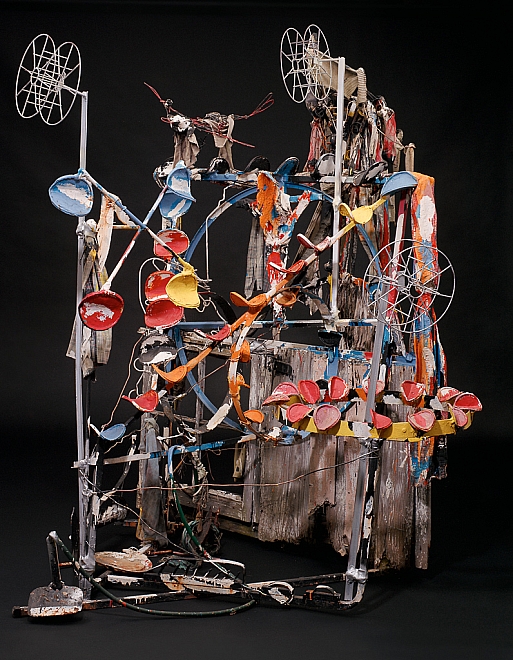Lonnie Holley’s Vision Land, a work about Dial’s good friend and fellow artist Lonnie Holley, address the experience of being a black self-taught artist. It is a symbolic rendering of the art environment built by Holley that stood for many years on his wooded, hilly property near the Birmingham Airport. More specifically, it is a meditation on the tragic fate that eventually befell Holley’s creative work and on the suppression of the African American generative spirit.
A vast and sprawling yard installation, Holley’s environment contained thousands of sculptural assemblages made of cast-off and recycled materials. Set on the ground, hung from trees, and perched on fence posts, these found-object pieces were joined by countless sandstone carvings, figures made of bent wire, and paintings. For many who visited Holley’s world, it was a magical and transformative domain. Rooted in the metaphysics of southern yard art, it was a place where old chairs became the signifiers of ancestral memory, broken-down television sets channeled communication with the realm of the spirit, and discarded tires came to encode the cyclical process of life and death.
Yet the wonder of Holley’s environment, as well as the fact that it had received praise from a coterie of national and international art critics and scholars, was not enough to ensure its survival. In the 1990s, when the City of Birmingham decided to expand its nearby airport, the department of sanitation charged Holley with maintaining a dump full of “debris and worn-out appliances,” and condemned his property as a “health hazard.” Finally, after a long battle by the artist and his small band of supporters, Holley removed as many artworks as he could. Then the authorities bulldozed what was left of the sculpture park.
Intended as a memorial to Holley’s art environment, Dial’s Vision Land is built on an old window frame and discarded strips of metal, the kind of material remnants one would have found in Holley’s yard. At the base of the piece, Dial has placed miniature cars and trucks, reminders of the rusted auto and truck bodies that were also a part of Holley’s collection of lost and abandoned objects. Suspended toward the top of the rickety assemblage, an abstract airplane made of wire and cloth swoops and soars like the aircraft from the Birmingham airport that regularly few over Holley’s land. Mounted around the airplane are three round wire spools reminiscent of the helicopters from a local Air National Guard depot that also used to hover over the property. Additionally appearing within the assemblage is an actual artwork by Holley, one of his signature bent-wire portraits, which he made during a visit to Dial’s home.
In portraying Lonnie Holley’s creative world, Dial curiously infuses his depiction with a sense of the carnivalesque. For instance, the spools that recall the National Guard helicopters also double as miniature Ferris wheels. Evoking another metaphor for the carnival, Dial mounts brightly colored paint can lids on rods and wheels to form what appears to be a jumble of twirling and plunging rides at an amusement park. Symbolizing Holley’s identity as an artist, these paint contraptions. By invoking the carnivalesque in this way, Dial captures the whimsy of Holley’s art as well as the absurdity of a world that would allow its destruction. Then, in a final twist from the comic to the tragic, Dial includes a crucifixion at the heart of his playful construction. The figure on the cross, cut from sheet metal, represents Holley, his persecution, and the annihilation of his vision by the City of Birmingham.
